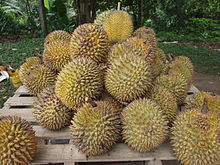– **Etymology and Taxonomy:**
– The name “durian” originates from the Malay word ‘duri’ meaning thorn.
– Historical variants include ‘duryoen,’ ‘duroyen,’ ‘durean,’ and ‘dorian.’
– Durio zibethinus is the type species derived from Viverra zibetha.
– Durio sensu lato encompasses 30 recognized species, with Durio sensu stricto comprising 24 of them.
– Durio s.l. includes 6 additional species, now considered their own genus.
– Durio is placed in the family Bombacaceae or Malvaceae.
– **Description and Cultivars:**
– Durian trees can grow up to 50 meters in height and have one or two fruiting periods annually.
– Among the 30 known Durio species, 9 produce edible fruits.
– The fruit can reach sizes of up to 30cm long and 15cm in diameter.
– Numerous durian cultivars have been developed in Southeast Asia over time.
– Cultivars are propagated by vegetative clones, with distinct colors and flavors among different varieties.
– Grafting is a common method for propagating durian cultivars.
– **Culinary Use and Variations:**
– Durian fruit is consumed at various ripeness stages and used in Southeast Asian cuisines to flavor dishes.
– The seeds of durian can also be eaten when cooked.
– The fruit’s aroma is perceived differently by individuals, with some finding it pleasant and others overpowering.
– Variations in fruit shape and spines impact the appearance of durians.
– Consumers may have preferences for specific fruit shapes, with certain varieties commanding higher prices.
– **Malaysian Durian Varieties:**
– Over 200 durian varieties are registered in Southeast Asia, with 13 common Malaysian varieties known for their desirable qualities.
– The Malaysian Ministry of Agriculture registers durian varieties, and competitions identify superior cultivars.
– Musang King (Mao Shan Wang) is a premium Malaysian durian variety with bright yellow flesh.
– Other popular Malaysian durian cultivars include D24 (Sultan), XO durian, Tekka durian, and D168 (IOI), each offering unique flavors and textures.
– **Market Value and Preferences:**
– Consumers express preferences for specific durian cultivars, with superior varieties commanding higher prices.
– Durian cultivars are assigned common names and code numbers, and those with high yields and disease resistance are valued in the market.
– Durian cultivars with appealing qualities are identified through competitions, with Musang King being a highly sought-after variety.
The durian (/ˈdʊəriən/, /ˈdjʊəriən/) is the edible fruit of several tree species belonging to the genus Durio. There are 30 recognized Durio species, at least nine of which produce edible fruit. Durio zibethinus, native to Borneo and Sumatra, is the only species available on the international market. It has over 300 named varieties in Thailand and 100 in Malaysia as of 1987. Other species are sold in their local regions.
| Durian | |
|---|---|

| |
| Durians at a market | |

| |
| Cut durian revealing its pulp | |
| Scientific classification | |
| Kingdom: | Plantae |
| Clade: | Tracheophytes |
| Clade: | Angiosperms |
| Clade: | Eudicots |
| Clade: | Rosids |
| Order: | Malvales |
| Family: | Malvaceae |
| Subfamily: | Helicteroideae |
| Tribe: | Durioneae |
| Genus: | Durio L. |
| Type species | |
| Durio zibethinus L.
| |
| Species | |
|
There are currently 30 recognised species (see the List of Durio species) | |
Named in some regions as the "king of fruits", the durian is distinctive for its large size, strong odour, and thorn-covered rind. The fruit can grow as large as 30 cm (12 in) long and 15 cm (5.9 in) in diameter, and it typically weighs 1 to 3 kg (2.2 to 6.6 lb). Its shape ranges from oblong to round, the colour of its husk from green to brown, and its flesh from pale yellow to red, depending on the species.
Some people regard the durian as having a pleasantly sweet fragrance, whereas others find the aroma overpowering and unpleasant. The smell evokes reactions ranging from deep appreciation to intense disgust. The persistence of its odour, which may linger for several days, has led some hotels and public transportation services in Southeast Asia to ban the fruit. The flesh can be consumed at various stages of ripeness, and it is used to flavour a wide variety of savoury and sweet desserts in Southeast Asian cuisines. The seeds can also be eaten when cooked.
